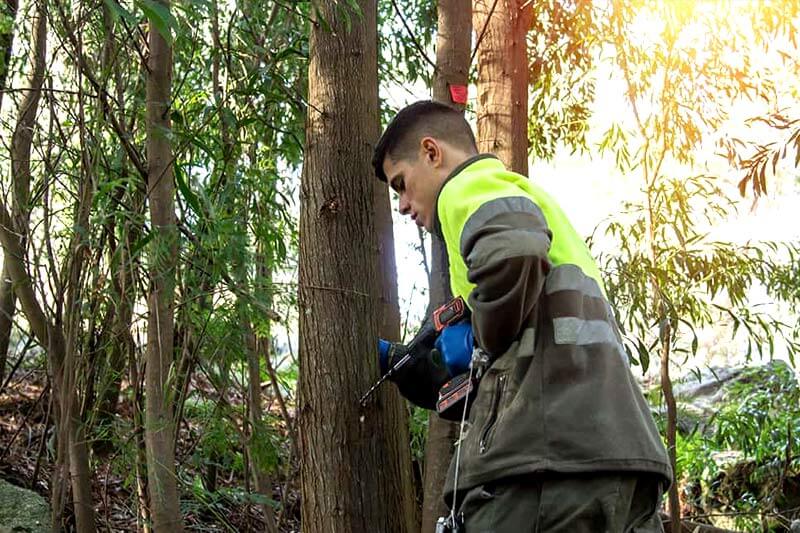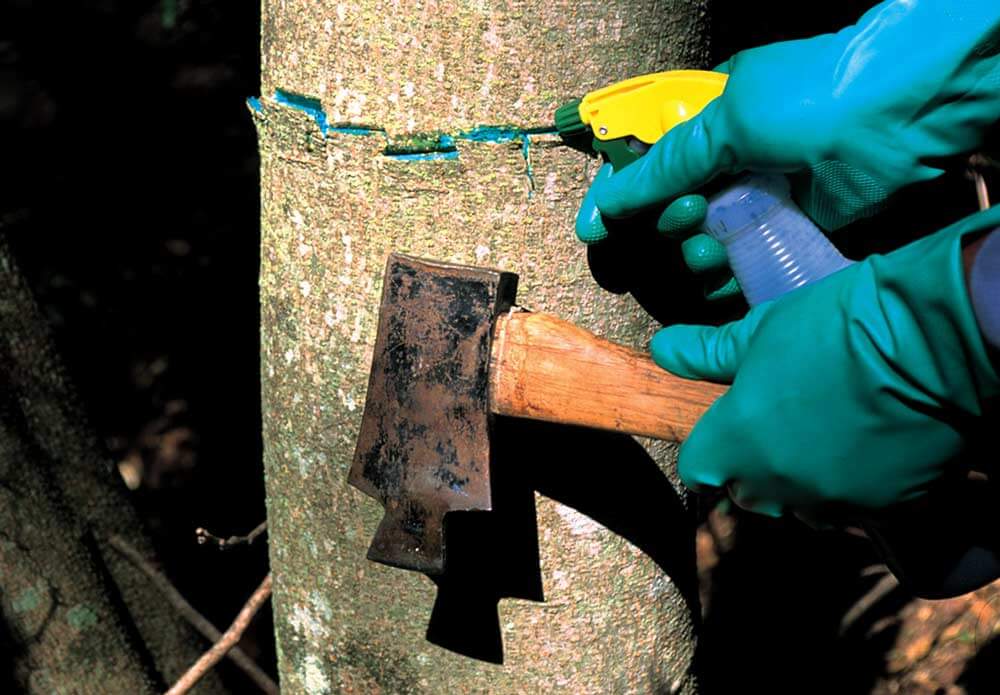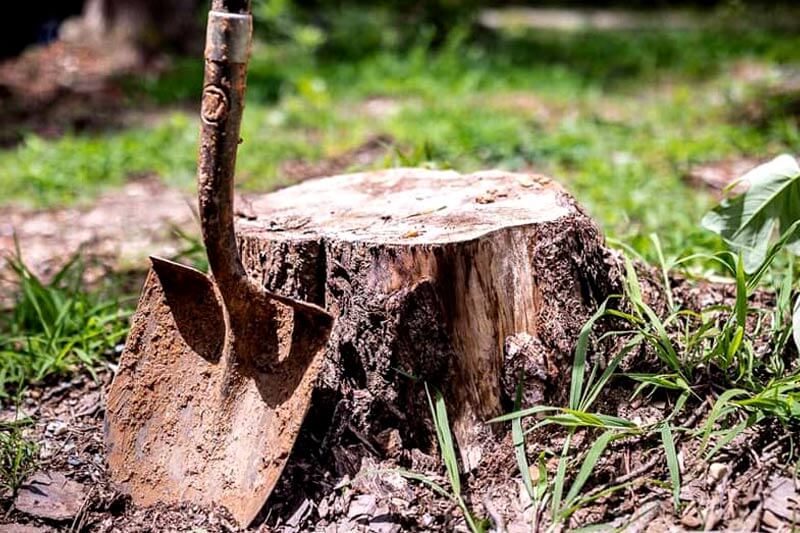It’s imperative not to destroy trees without significant justification, given their environmental benefits. Yet, there are instances when removing the tree becomes unavoidable. This may be due to the tree overwhelming your property, obstructing your view, posing a safety risk, or merely because you prefer it gone.
The best way to secretly kill a tree is to do it slowly so it doesn’t die overnight. You can also use salt on the ground around the tree, copper nails into roots or the trunk, Copper sulfate, muriatic acid, or even kill the tree by overwatering.
It might take a bit of time to get the dosage right so start with small amounts and slowly increase the dose over time.

What we cover
ToggleTordon herbicide injections
An herbicide kills a tree faster and more easily and safely than anything else. Tordon1 is the most powerful herbicide that will kill any tree from the inside out while the tree stands in place.
There are different ways to achieve this. One way is to locate or dig out one of the roots, drill holes into the root beneath the soil, and fill them with Tordon. Then you’ll cover the holes with a rug and put the soil back on top of the roots. After a few days, the tree will die, leaving no visible evidence of poisoning.
You can also drill holes into the tree’s trunk, which may get exposed later. Treat the tree on a hot day without rain for the herbicide to take full effect.

Foliar spray method
Trees under 15 feet tall can be killed by spraying the foliage with Roundup or a selective weed killer, such as 2,4-D. The good thing about this method is that it is effective both in spring and summer. It’s important to spray on a windless day so the herbicide is not carried onto nearby trees or garden plants.
Even though larger trees will resist this method, if the tree you’re looking to remove is small enough, you can kill it with a foliar spray.
What other chemicals can be used to kill a tree?
Some herbicides are specially made to kill trees. If properly applied, they can also be safe for the environment. The most environmentally friendly application method involves applying herbicide to a specific area of the tree. In some cases, you may need to use herbicidal spray.
There are five major types of herbicides, only some of which are rated for home or crop use. Triclopyr amine and triclopyr ester are growth regulator-type herbicides, while glyphosate and imazapyr kill plants by interfering with the synthesis of plant proteins.
Aminopyralid is primarily effective on legumes such as kudzu and may not be appropriate for your needs. Some of the techniques you can apply while trying to secretly kill a tree with chemicals are outlined below:
Cut Surface Treatments
This technique involves creating a pathway through the bark so that herbicide can be introduced into the plant’s vascular tissue.
Start by making a series of downward cuts around the circumference of the tree with an ax or hatchet, leaving the frill (cut section of bark) connected to the tree. Immediately apply the selected herbicide to the cuts.
Avoiding spring applications when sap flowing from the wound will prevent good absorption. You can return the bark to ensure that the cut part of the tree is not exposed.

Injection treatments
Use specialized tree injection equipment to administer a specific amount of herbicide into the tree when the cut is made. Treatments are effective when injections are made every 2 to 6 inches around the tree.
For best results, treat trees 1.5 inches or more in diameter at chest height. Injection is often handled by a tree removal company because it requires specialized equipment.
Stump treatments
Suppose the tree is already cut down and you don’t want it to sprout. In that case, you can eliminate the possibility of regrowth by immediately treating the freshly cut surface with herbicide to prevent sprouting.
On larger trees, treat only the outer 2 to 3 inches, including the cambium layer, of the stump (the internal heartwood of the tree is already dead). Treat the entire cut surface for trees 3 inches or less in diameter.
Soil treatments: If you plan to kill more than one tree, soil treatment with chemicals may be the recommended option. Certain soil treatments can be applied evenly to the soil surface, which will move into the root zone of targeted plants after ample rainfall or overhead moisture.

Secretly kill a tree with high salt doses
In high dosages, salts can be deadly for plants. The sodium in salt will prevent the flow of potassium and magnesium, which are essential in the making of chlorophyll, the green photosynthetic pigment. That being so, the lack of chlorophyll will kill the tree as a result of nutrient deficiency.
Therefore, when looking for an efficient way to secretly poison a tree, salt will do the job. To ensure that you are able to selectively kill the tree without affecting other vegetation around, follow the steps below to do it the right way.
- Drill from four to six ½-inch holes, at least 3 inches deep, around the target tree, and fill them with salt. The holes should be drilled diagonally.
- Mix one part water with two parts salt. You can go with mixing 3 cups of water and 6 cups of salt in a container.
- Fill the holes with the solution. When it dissipates, refill them. Keep doing this weekly. After a while, you’ll notice that the foliage on the tree starts turning brown, indicating that you’re doing things right. The tree will eventually die off.
Secretly kill a tree with copper nails
If you’re not in a hurry for fast results, you can find solace in killing that tree with copper nails without leaving lasting damage. There’s no size requirement for the nail to use, however, the longer and wider the nail, the more efficient the treatment.
You should follow the steps below if you want to employ this method:
- Hammer in a copper nail near the base of the tree at a slight angle pointing downward.
- You don’t stop hammering a single copper nail into the tree. Hammer as many copper nails as you can about half an inch apart. This way, the concentration of copper in the tree will increase, which will result in metal oxidizing. This will, in turn, poison the tree and lead to its death.
- Remember that you’re doing this secretly, so leaving no trace is good. Cover the nail heads with mud once you’ve hammered them into the tree.
- Once the tree dies, you can go ahead and remove the nails.
- Remember that this is a slow process that will take time, sometimes up to one or two years, to get the desired outcome.
Kill a tree with copper sulfate
Copper sulfate is a poison used to discourage the growth of tree roots in vulnerable areas. But, when applied properly, it’ll also kill the whole tree. However, never apply the copper sulfate on the ground around the tree, but directly into the tree instead since it can get into the water supply. Here’s how to gradually kill your tree with copper sulfate solution:
- Near the base of the tree, peel about two inches of bark.
- Drill a hole downwards. The hole size depends on how fast you want to kill the tree. A large hole will allow a higher amount of copper sulfate.
- Fill the hole with copper sulfate using a funnel.
- Push the bark back into place to ensure that the copper sulfate is intact.
This will prevent the copper sulfate solution from raining and make it less obvious that the tree is poisoned.
Muriatic acid
Hydrochloric acid, also known as Muriatic acid is a harsh chemical, which burns through pretty much anything it touches. For this reason, it’s a suitable killer for both weeds and trees in your yard.
But, make sure to apply it only on the target tree; otherwise, the acid will kill any plant in the area. You should also avoid spilling it in your yard to avoid acidifying your landscape, soil, and groundwater.
Start by digging a trench around the tree, deep enough to expose the roots. Then, mix the muriatic acid with water in a metal container, according to the recommended ratio on the bottle. Finally, pour the solution directly onto the tree roots.
It’s important to always wear rubber gloves and goggles when using acid due to its toxicity.
Kill a tree with acidic water
This is a safer option compared to the Muriatic acid method applied above. If you’re using this method, you only need to dilute a small amount of acid in a large portion of water.
This is a simple method that requires you to continuously water the target tree with acidic water- that is, water whose pH value is below 6.5. It’ll most certainly kill the tree without a trace.
Generally, plants thrive with a pH of about 5.5 to 6.5. The acidic environment can lower the levels of phosphorus, calcium, magnesium, and molybdenum, nutrients that are essential to plant growth. Also, low pH levels will create mineral levels in the soil, which are toxic and, therefore, harmful to plants, including trees.
This method is not always recommended because the acidic water will not only be affecting the target tree but also a lot of vegetation close to the tree.
Overwatering
It’s more likely to kill a tree with excess water than insufficient water. Think of this as a tree being affected by flood. Flooding may cause direct damage to trees by changing soil conditions, interrupting normal oxygen and carbon dioxide exchange between trees and their environment, sedimentation, and physical damage.
Flooding also can weaken trees, making them more susceptible to damage from insects and diseases. The likelihood of insect and disease damage depends upon the severity of the flood and tree health.
A tree in weak condition before a flood can be further stressed by flooding. Trees that are flood-stressed exhibit a range of symptoms such as leaf chlorosis (yellowing), leaf loss, reduced leaf size, early fall coloration, and leaf drop.
Other symptoms are the emergence of waterspouts or small shoots from the main stem, and crown dieback. If these symptoms persist for a long time, the tree will end up dying.
In the same way, watering a tree with more water than it needs is a surefire way of gradually and secretly killing such a tree.
Affordable tree removal service near me
If you’re planning to secretly remove your tree to cut down costs, you may discard the idea. Using this FREE service, you can easily get 3 Estimates from the most affordable tree services near you.
GoTreeQuotes.com quickly matches you with the three tree surgeons voted #1 by previous users in your area.
- Scroll up to the top of the page and enter your ZIP Code in the blue form at the top of the page.
- Give us a few details about your tree trimming or removal job, plus some contact information.
- Your tree details are forwarded to the closest tree-cutting services all voted best priced, who will also price your tree job.

FAQ's
Applying vinegar on the tree leaves is usually not enough to kill the whole tree. However, when it is successful in killing the leaves, the tree will become less capable of photosynthesizing and transferring carbohydrates to the roots, which is essential for its growth. When this happens, it becomes a gradual death call for the tree.
Roundup can only kill weed trees and small trees that are under four feet. On the other hand, it won’t be as efficient with larger ones. To kill a large tree, you should combine Roundup with other chemicals.
Epsom salt is hygroscopic, with the crystals having the ability to absorb water. This property is why Epsom salt will continue to absorb moisture from a tree until there’s no water for it to survive on. This is a secret and gradual death trick you can use to kill a tree.
- Steven Cooper, (2021) Tordon RTU: Complete User Guide <https://backyardables.com/tordon-rtu-complete-user-guide/> Accessed: 08-02-2024




